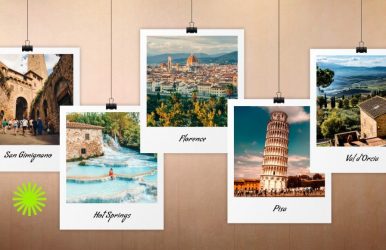An Unforgettable Journey From Milan To Lake Como: How To Travel The Distance?
BY Sibashree Jun 26, 2025
This time, our journey takes us to Lake Como, situated in the foothills of the Swiss Alps. The beautiful lake has been in the news recently for being the “Muse” for Chanel’s cruise 25/26 show. Nevertheless, the pristine waters of the lake, quaint towns, and stunning villas here teach us the art of slow traveling. You can just sit by the water, relax, and soak in the moment by doing nothing. Furthermore, the journey from Milan to Lake Como is an experience in itself. You will love the scenic views, cultural exploration, and more during the trip. Which Month Is Best In Milan? Learn The Best Time From A Milan To Lake Como Journey April to May and September to October are the best months for a Milan to Lake Como trip. June to August is very hot and humid in Milan, with temperatures peaking at over 30 degrees Celsius in July. Furthermore, the winter months in Milan are damp and chilly. However, the opera season at La Scala runs from November to December, and Christmas and New Year celebrations continue through December and January. So, you can plan a visit in these months to soak in the festive fervor of Northern Italy. Do you want to know more about the weather conditions in Milan? Have a look at the table below. Months Highest Temperature (°C) Lowest Temperature (°C) Days of Rainfall January 8 2 6 February 11 4 4 March 16 8 5 April 18 10 8 May 25 15 8 June 28 17 7 July 31 20 5 August 30 21 6 September 25 17 6 October 17 13 7 November 12 7 6 December 8 2 6 What Is The Milan To Lake Como Distance? How Do I Get To Lake Di Como From Milan? The distance between Milan and Lake Como is approximately 50 kilometers (31 miles). You can complete the journey within an hour. Also, the journey offers you a seamless transition from the bustling city of Milan to the tranquil beauty of Lake Como. 1. Milan To Lake Como Train A train ride from Milan to Lake Como is convenient, and the journey offers stunning scenic views as the train passes through small villages and lush greenery. You can take the regional train running from Milano Centrale or Milano Porta Garibaldi to Como San Giovanni, the primary station in the city of Como. The train ride takes approximately 40 minutes. However, you can also take a EuroCity Milan to Lake Como high-speed train from Milano Centrale to Como San Giovanni Station. These trains take close to 36 minutes (some trains may take longer). What Is The Milan To Lake Como Train Time? Have a look at the table below to learn about the train timings. Slow Trains Faster Trains Departure from Milano Centrale Arrival at Como San Giovanni Departure from Milano Centrale Arrival at Como San Giovanni 06:43 AM 07:22 AM 7:10 AM 7:52 AM 06:55 AM 07:44 AM 8:10 AM 8:47 AM 07:43 AM 08:22 AM 9:10 AM 9:47 AM 08:43 AM 09:22 AM 10:10 AM 10:56 AM 09:43 AM 10:22 AM 11:10 AM 11:47 AM 10:43 AM 11:22 AM 1:10 PM 1:47 PM 11:43 AM 12:22 PM 3:10 AM 3:47 PM 11:55 AM 01:18 PM 4:10 PM 4:47 PM 12:43 AM 1:22 PM 5:10 PM 5:47 PM 12:55 PM 2:18 PM 6:10 PM 6:47 PM 1:43 PM 2:22 PM 7:10 PM 7:47 PM 1:55 PM 3:18 PM 2:43 PM 3:22 PM 2:55 PM 4:18 PM 3:43 PM 4:22 PM 3:55 PM 5:18 PM 4:43 PM 5:22 PM 4:55 PM 6:18 PM 5:43 PM 6:22 PM 5:55 PM 7:18 PM 6:43 PM 7:22 PM 6:55 PM 8:18 PM 7:43 PM 8:22 PM 8:43 PM 9:22 PM 9:43 PM 10:22 PM 10:43 PM 11:22 PM How Much Is A Train Ticket From Milan To Lake Como? The Milan to Lake train ticket price starts from $7 (2nd Class/Standard), and for the first class tickets, you will need to pay $10. After reaching the Como San Giovanni station, you can take public transport or explore the city on foot. You will love the towns by the shore of Lake Como, including Bellagio, Varenna, and Tremezzo. 2. Milan To Lake Como Day Trip By Car A Milan to Lake Como drive is the best option if you want to enjoy the journey at your own pace. Traffic conditions keep differing. However, the journey by road typically takes around 1 hour and 15 minutes on average. Furthermore, as you advance following the A9 motorway, you will find the mesmerizing views of the Alps on one side and the appeal of Lake Como on the other side. However, the roads around the lake can be winding and narrow sometimes. So, be careful with the navigation. Also, don’t forget a stopover at Manza and Pavia. Manza has Autodromo Nazionale Monza, a popular Formula 1 race track. Pavia, on the other hand, is home to the Certosa di Pavia. It is a noted Carthusian monastery, popular for its artistic and historic heritage. 3. Milan To Lake Como By Bus You can take a bus from Milan to Lake Como. It is the cheapest way to reach Lake Como from Milan. However, the journey takes around 2 hours, and the buses depart from the Lampugnano station, running to Como and various lakeside towns. 4. Milan To Lake Como By Boat If you want to make your journey from Milan to Lake Como more meaningful, you can take a train to Varenna and take a ferry from there to Como. You can also take a ferry ride to Bellagio. The boat ride is beautiful, and you will love gliding through the turquoise waters. Is Lake Como Worth Visiting? Know What To Do In Lake Como Once you reach Lake Como, you can also visit the following places and enjoy several water activities. 1. Visit The Como City The largest city on the lake, Como, has a stunning lakeside promenade, historic architecture, and vibrant atmosphere. Furthermore, it is home to the Como Cathedral. The cathedral stands out thanks to its Renaissance and Gothic architecture. Also, you will love the cafes, restaurants, and shops throughout the historic center. Moreover, don’t miss a funicular railway ride to the hilltop town of Brunate. You will love the panoramic views of Lake Como and the surrounding mountains from there. Additionally, for a taste of local culture, visit the Tempio Voltiano, a museum dedicated to the life and work of Alessandro Volta, the inventor of the electric battery, who was born in Como. 2. Explore Bellagio Historic villas Cobblestone streets Scenic beauty All these make Bellagio the “Pearl of Lake Como.” Also, it is located at the juncture of the two arms of Lake Como. So, you will enjoy a stroll along the narrow and winding alleys of Bellagio, piazzas, and lush gardens. Moreover, for an idyllic experience, you must visit the surrounding gardens of Villa Melzi. Also, you can explore the gelato stands, cafes, and boutique shops. You can even cycle the surrounding hills, go hiking, and take part in water sports. 3. A Trip To Varenna Varenna is one of the best towns to visit in Lake Como. This town on the eastern shore of Lake Como exudes the quintessential romantic charm and a laid-back vibe. Also, it is an ideal destination for Instagrammable tours in Italy. It has a beautiful waterfront and colorful buildings. Moreover, Villa Monastero, with its beautiful gardens, and Castello di Vezio, a medieval fortress overlooking the town, are some iconic landmarks here. 4. Water Activities Do you want some serious adventure at Lake Como? Try the following activities. Sailing Kayaking Paddleboarding 5. Dining On Lake Como It’s a sin not to try fresh lake fish, such as perch and trout, when you are at Lake Como. You will love these delicacies after a Milan to Lake Como journey, and these dishes served with polenta do the real magic. You will also love risottos here and look for the best Italian wines. Do you want a more luxurious experience? You can try fine dining at any of the Michelin-starred restaurants in the nearby towns. Enjoy the delicacy while enjoying the amazing views of the lake. Milan To Lake Como: Frequently Asked Questions (FAQs) Here are the frequently asked questions and answers about the Milan to Lake Como journey. 1. Is 1 Day Enough For Lake Como? Yes, one day is enough if you want to explore the nearby towns and try out the water activities. However, if you want to know about the local culture, you can stay longer. 2. What Is The Best Way To Travel From Lake Como To Milan? Taking a superfast train from Milan to Lake Como is the best way to travel. The travel time is less than 40 minutes, and the ticket prices start from $7. 3. Is Lake Como Expensive To Visit? Yes, Lake Como is considered one of the best places for high-end tourism in Italy. However, you can plan a stay in areas such as Lecco and visit the lake during the shoulder seasons to avoid the extra cost. 4. How Many Days Do You Need In Lake Como? You can go for a day trip from Milan to Lake Como. However, if you have hiking plans and if you want to visit even the smaller villages, you will need at least three to five days. 5. What To Visit In Milan In 2 Days? The places to visit in Milan in 2 days are Duomo, Galleria Vittorio Emanuele II, the Navigli district, and Sforza Castle. 6. How Many Days In Milan Is Enough? You need at least two to three days to visit the major attractions in Milan. 7. What Is Special In Milan? Milan stands proud as the global epicenter of luxury fashion. Names such as Versace, Prada, Valentino, and Armani call Milan their home. 8. Is It Worth Going To Lake Como From Milan? Yes, the Milan to Lake Como journey is easy, and it offers a welcome relief from the hustle and bustle of Milan. Also, you will love the scenic views along the journey.
















